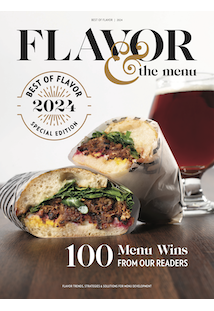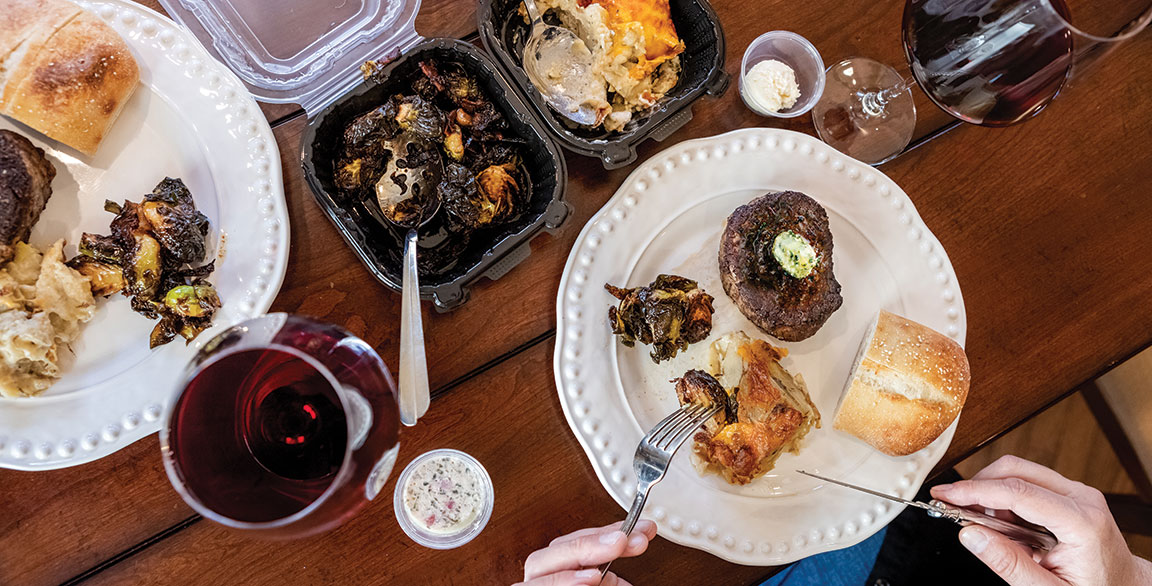

We all know that the foodservice industry got knocked off its feet this year. To say that standing back up has taken enormous effort is an understatement. To get back up, restaurant brands have had to pivot, turn, recalibrate and rethink. They’ve taken a long look within their four walls, shored up their brands’ foundations and forged new paths forward. We sat down with 10 insightful, creative and passionate chefs in high-volume foodservice and asked them to share what their game plans look like. And you better believe they each have one—hatched during the lockdown, enacted quickly for early wins and strategized carefully for the long game.
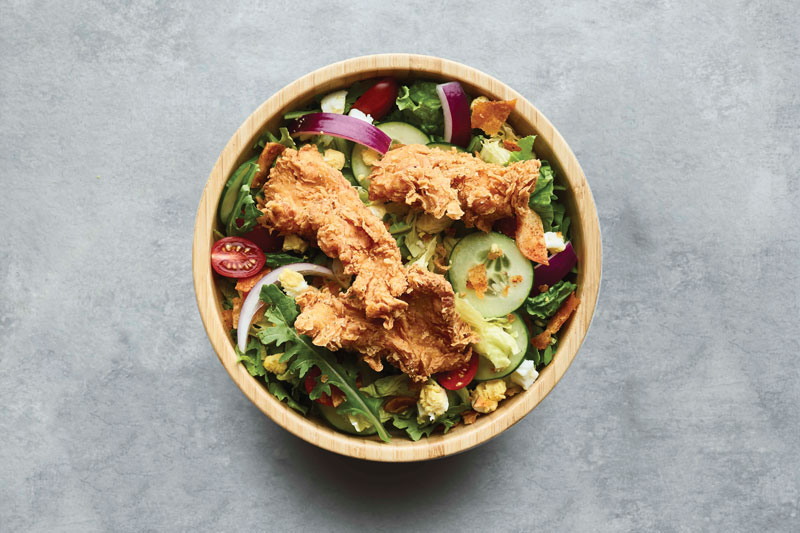 Aussie Grill
Aussie Grill Fast casual Aussie Grill ensures a crispy to-go experience of its fried chicken tenders through a strategic breading process and method of evacuating steam, perfected by sister concept Outback in its efforts to ensure its signature Bloomin’ Onion delivers on its brand promise.
What did we learn?
The word “nimble” isn’t often used to describe chain innovation, no matter how successful that innovation is. But when asking our roundtable of chefs what they learned from this singular, surreal, challenging experience, that word pops up a lot.
“We saw that we had to be flexible in our thinking and nimble in our individual markets,” says Alex Sadowsky, corporate executive chef of Dallas-based Twin Peaks, which closed its doors completely during the shutdown, with no curbside/delivery in play. “What we learned during that time is that nothing on the menu is sacred—top to bottom. With everything changing all of the time, we knew we had to instill that flexibility so we could make quick decisions on everything from sourcing of ingredients to shrinking menus based on labor and supply issues. We knew with everything we did, we had to get there as fast as possible to be successful. I’ve never been busier than when we were shut down.”
Twin Peaks and the culinary team spent that time developing a post-shutdown playbook focused on flavor innovation and curbside/delivery, knowing that off-premise would play a much larger role in the newly sculpted landscape.
Brand introspection played a big part in opening up an environment for quick thinking and long-term innovating. “A big question we asked ourselves during all of this was ‘What are our core values that we hold dear and won’t budge on?’” he says. “Everything else was fair game so we could be better set up to succeed.”
Of course, crystallizing strong brand identities is always important, but Sadowsky and other chain chefs we spoke with applied deeper scrutiny to theirs in order to sharpen menus and prep for the coming sea changes in consumer behavior.
“From a culinary perspective, we used that quarantine time as a wake-up call,” says Molly McGrath, chef and culinary director of fast casual Rōti Modern Mediterranean, which stayed open throughout the crisis, but saw a huge reduction in foot traffic, naturally. “We laser focused on the future, and we declared that there were no sacred cows on our menu. COVID turned everything on its head anyway, so why not test all of the ideas that have occurred to us? Let’s not be safe about it and see where it takes us. We learned that the time is always right for innovation.”
Efrem Cutler, corporate executive chef of Bloomin’ Brands International, says that the global restaurant group strengthened collaboration within its brand universe. “We learned from each other and helped each other. We had to be nimble, which is challenging when you look at the volume we do,” he says.
That volume covers three casual dining brands, one fine dining and one fast casual: Outback Steakhouse, Carrabba’s Italian Grill, Bonefish Grill, Fleming’s Prime Steakhouse & Wine Bar, and Aussie Grill by Outback, respectively. During the shutdown, all of the concepts offered curbside/delivery.
When Fleming’s moved from a dine-in only model to off-premise—a “pivot” that took only six days to roll out—it used the takeout containers from Outback and Carrabba’s, for instance. “We were less concerned about brand fit and more about getting rolling—that ‘in-it-together’ approach gave us freedom to problem solve and shift quickly. Progress over perfection is how we figured we’d proceed,” he says.
Fleming’s has discovered a whole new set of consumers that perhaps didn’t consider us before, but they are now. We got there through delivery. I’ll take that all day long.
Efrem Cutler, Corporate Executive Chef, Bloomin’ Brands International
For many brands, drawing on a well of ingenuity and flexibility in order to put out fires during those early days of lost revenue demonstrated that those waters run deep. And that’s a good thing, given the unprecedented challenges that face the industry. Agility and innovation are the order of the day as chefs need to hone their menus, key into changing consumer preferences, work through supply and labor issues, and recalibrate for a world that has vaulted delivery-friendly menu development into a top brand priority.
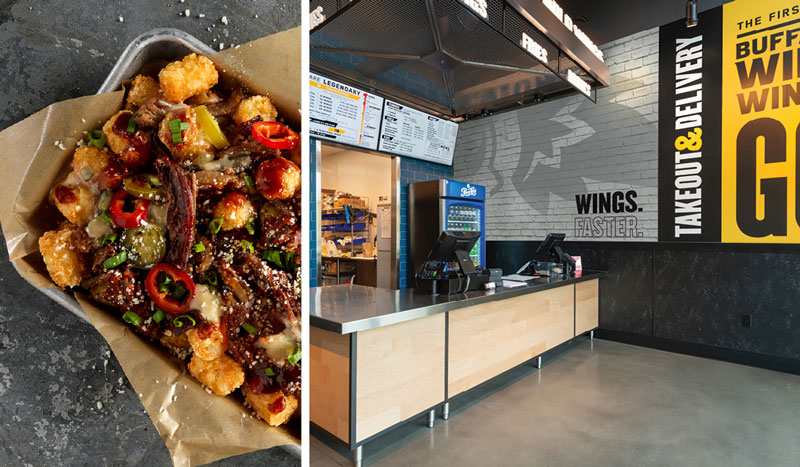 Buffalo Wild Wings
Buffalo Wild Wings Buffalo Wild Wings’ Dirty Dubs Tots are part of the chain’s new smoked brisket launch. The tots sport Hatch queso, adobo, honey barbecue, pickled jalapeño, Fresno chiles and Cotija. Buffalo Wild Wings GO opened its first location in June, helping the brand maximize delivery opportunities.
DELIVERY AND TO-GO CALCULATIONS
Most chains have been hard at work for a while now, cracking the code for success in delivery and grappling with how to translate a brand experience into a to-go bag without losing the integrity of that experience. The pandemic and its impact on brick-and-mortar closures has called for a little jerry-rigging in temporary fixes and a lot of planning for robust and profitable delivery models.
The Road to Connectivity
Of course, the shutdown boosted sales in curbside/delivery across the board. But more importantly, the pandemic has fostered a stronger culture around off-premise; consumer habits were either formed out of necessity or reinforced because of circumstance. Either way, delivery is even more entrenched in consumers’ lives. Also, in a more bleak scenario, brands are facing the potential for future shutdowns, and they want their delivery arm to be as strong as possible.
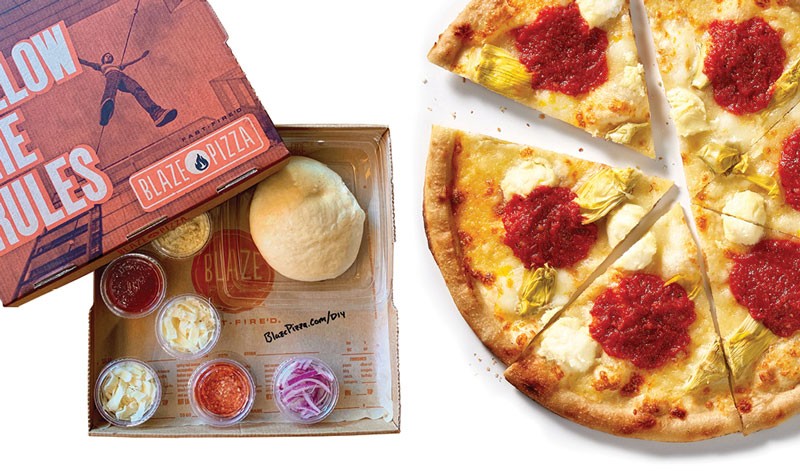 Blaze Pizza
Blaze Pizza Blaze Pizza extended its reach and personal touch through how-to videos that helped guests recreate the brand experience at home after purchasing its DIY kits, loaded with all of the pizza-making essentials. Larger 14-inch classic-dough pizzas, like the Art Lover with artichokes, mozzarella, ricotta, garlic and red sauce, were designed for at-home sharing.
Apart from working through the engineering side of things—line space, optimized packaging for proper texture and heat, third-party partnerships and so on—brands have been exploring ways to create community and connection via delivery and takeout. Some have seen tremendous opportunity born from necessity.
“The store closures forced people to think of Blaze as a delivery option,” says Brad Kent, chief culinary officer of Blaze Pizza, a fast-casual pizza concept based in Pasadena, Calif. “That really wasn’t part of our brand personality before COVID, with most guests coming into our stores. We actually foresee sales in online ordering going even higher once we reopen the storefronts.” Circumstance propelled innovation in this space, and Kent says that it has opened up new avenues of growth. “We now have full-scale delivery, curbside pickup, DIY meal kits and take-and-bake pizzas,” he says.
The crust-to-toppings ratios that the legacy players use are designed for a reason. They stay hotter and fresher longer in delivery. Moving from 2 to 3.5 millimeters gives the pizza a more bread-like consistency that holds toppings well and maintains its integrity better.
Brad Kent, Chief Culinary Officer, Blaze Pizza
To support those nascent initiatives, Blaze looked at how it could create brand engagement with guests at home. The company started running cooking videos on Instagram, teaching customers how to assemble its DIY kits, which include a dough ball, dusting flour, sauce and up to seven toppings. It also launched online-only Blazin’ Bundles, with promotions that move beyond just a pizza delivery and into a fun solution for the new normal, such as bundling a large build-your-own pizza with four dough knots for future at-home pizza-making parties.
Perhaps equally important to building revenue, innovations like DIY kits helped forge connections between Blaze and its socially-distanced customers. “We have found a new way of relating to our audience through those demo videos while growing our presence on social media, too,” says Kent.
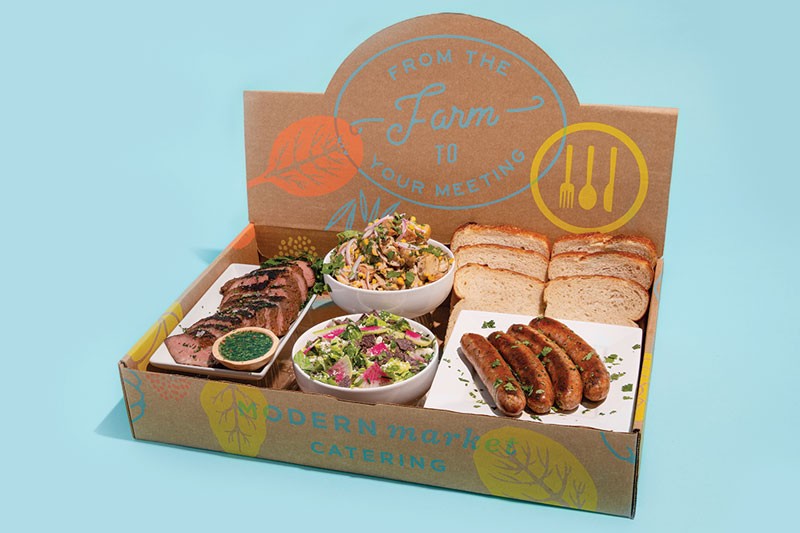 Modern Market
Modern Market Both Lemonade and Modern Market launched commodity boxes when storefronts closed, and have since added “experience boxes,” expanding the way consumers interact with their brands. Modern Market’s Father’s Day Box (above) featured grass-fed steak, sausages, spicy potato salad, scallion ranch salad and sourdough bread.
Brand engagement through delivery is perhaps an unexpected outcome, but an incredibly significant one. Bloomin’ Brands’ Cutler shares one of the most impactful lessons from Fleming’s foray into the delivery/takeout world. Outback was primed for takeout, setting up its delivery arm four years ago. “But any white tablecloths were opposed to it back then,” he says. “If you’re going to a Fleming’s Steakhouse and ordering a tomahawk, you want the whole experience—the ambiance, the wine service, someone crumbing your table.”
But then COVID struck, and Fleming’s moved its tomahawks into to-go containers. The brand was concerned that this model wouldn’t work for them since diners couldn’t replicate the complete Fleming’s experience at home. “Instead, it was a great learning experience for us on what guests really want,” says Cutler. “What we realized, fortunately for us, is that younger guests are looking to us for a different type of experience. They’re ordering that tomahawk or that steak, and our delicious sides, then tailgating with friends or picnicking in a park with a bottle of wine, all while enjoying a Fleming’s meal.” They’re curating their own experiences while enjoying the brand’s menu.
He notes that some of what makes Fleming’s and other white-tablecloth restaurants special to older generations—elements like the ambiance and the service—are not as important to younger demographics. “They want to make their own ambiance, create their own experiences outside of our four walls, but still appreciate the caliber and specialness of our food,” he says. “They’re being flexible and adaptable. Fleming’s has discovered a whole new set of consumers that perhaps didn’t consider us before, but they are now. We got there through delivery. I’ll take that all day long.”
Nate Weir is the VP of culinary with Modern Restaurant Concepts, parent company of Modern Market Eatery and Lemonade, two fast casuals that serve seasonally inspired, flavor-forward menus. He says both brands were primed and ready for the uptick in carryout/delivery given that each does a brisk business in that space already. But both concepts were still motivated to deepen their ties to their guests.
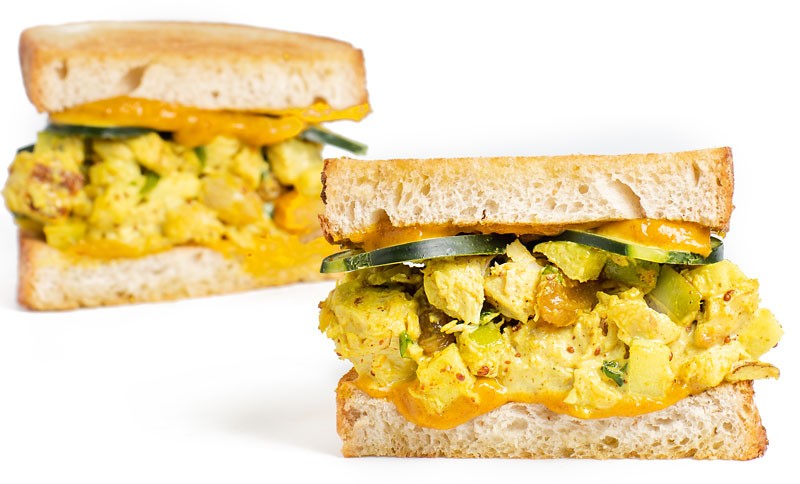 Lemonade
Lemonade Lemonade’s Curry Chicken Salad Sandwich demonstrates the fast casual’s adaptability. The chicken salad had only been available as a “scoop” in-store, but the brand created a sandwich platform to help turn over the prep item and sell it more easily through online delivery platforms.
“Consumers are going to be ordering takeout and delivery with more frequency, really weighing their decisions about going out,” he says. “We wanted to create a takeout experience that rivals restaurant experiences.” Early in the shutdown, both restaurants initially offered commodity boxes, like Modern Market’s Re-Fresh Box, packed with fresh produce for in-home meal prep. “We’ve moved away from straight commodity boxes to experience boxes,” says Weir. “We’re not a special occasion restaurant, but that doesn’t mean we can’t do special things for occasions.” The recent Father’s Day Box serves as example, offering a to-go kit of sous-vide grass-fed steak, sausage links, spicy potato salad, scallion ranch salad and sourdough bread.
Our aïolis and sauces are scratch-made, so extending their usage into these kits showcases our commitment to flavor and quality. We need to understand what our customers give us credit for and move those elements front and center.
Nate Weir, VP of Culinary, Modern Restaurant Concepts
For Weir, those creative delivery promotions do more than strengthen brand connectivity; they help tell Modern Market’s brand story about handcrafted ingredients. “Our aïolis and sauces are scratch-made, so extending their usage into these kits showcases our commitment to flavor and quality. We need to understand what our customers give us credit for and move those elements front and center,” he says.
Lemonade developed meal kits, too, including a Farmers’ Market Box. It also is working on reimagining menu favorites as at-home experiences. “We don’t serve tacos at Lemonade, but we have a fantastic Ahi Tuna Poke Bowl,” he says. “We’re repackaging it into a fun taco experience for the to-go consumer.”
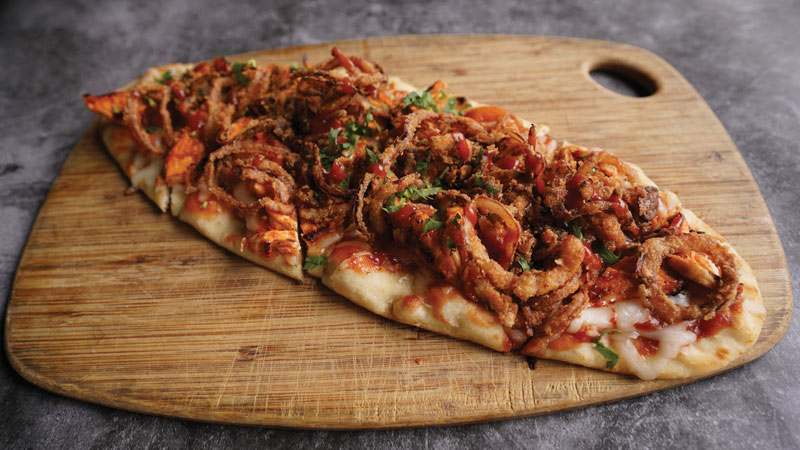 O.C. Breads & Bowls
O.C. Breads & Bowls O.C. Breads & Bowls, a new virtual kitchen operating out of Daily Grill’s back of house, serves delivery items only, like this BBQ Chicken Flatbread with fontina, barbecue chicken breast and crispy fried onions.
Creative Solutions
The chain chefs we spoke with have moved considerable resources into menu optimization and operational innovation for the to-go marketplace. Twin Peaks’ Sadowsky sees perfecting the quality of experience in a portable format as priority No. 1. “If you don’t plan for how it’s going to travel from the get-go, it won’t be good. We’re now putting R&D through that filter, asking first how we’re going to get a great flavor experience over to the guest’s house, then modifying those builds for in-house dining.” He’s flipping the R&D model and approaching menu innovation through an entirely different angle.
He also points to the psychographics of food delivery as a crucial part of the equation. “How do you develop an item that people think is good for delivery? There’s a built-in acceptance with pizza, Chinese food, wings, subs,” says Sadowsky. “We need third-party delivery companies to help figure that out. It’s the billion-dollar question for our industry today.”
Brands are looking to solve difficult issues regarding textural integrity and heat retention. Twin Peaks’ internal data points to consumers’ desire for optimal texture being stronger than their need for a hot-and-ready delivery. Pre-COVID, it switched to highly-vented packaging with moisture barrier pads on the base. “Knowing that they’ll sacrifice heat to keep crispiness intact is driving us harder to solve for that,” he says. But of course, temperature still plays into a great flavor experience.
“How long did it take Papa Murphy’s to figure out bakeable trays? We’ve started working on that with our family packs, using ovenable packaging for family meals. Do we make videos on how to warm up or reheat, maybe through a QR code on the packaging? We think our guests will be up for doing just a little bit of work to ensure a great at-home experience,” says Sadowsky.
Bloomin’ Brands’ Cutler drives home the importance of factoring in the realities of delivery. “Chefs must understand that the result of their vision is going to be in a Chevy Tahoe for 20 minutes, so they need to think about that before developing recipes,” he says. “That critical process will make the in-dining occasions better, too.”
At fast casual Aussie Grill, the fried chicken tenders don’t lose their crave factor because they maintain their signature crispiness. He points to a proprietary breading process as part of the success here and also gives credit to the method that Outback perfected when it had to solve the delivery issue of texture in its iconic Bloomin’ Onion. “We altered our process with the Bloomin’ Onion, which was a big deal because that is a sacred cow,” he says. “The blanket of hot air in the Crisp-N-Hold evacuates the steam from the product. That step reduces the temperature—from 212 degrees down to 200—but it’s still hot,” he says. Using that method with Aussie Grill’s fried chicken tenders has prevented any letdown of experience.
Blaze Pizza’s Kent developed a 14-inch shareable pizza with a thicker crust than its standard 11-inch pizza. “The crust-to-toppings ratios that the legacy players use are designed for a reason. They stay hotter and fresher longer in delivery. Moving from 2 to 3.5 millimeters gives the pizza a more bread-like consistency that holds toppings well and maintains its integrity better,” he says.
First Watch was testing a third-party delivery partnership in four markets before the pandemic struck. And talk about nimble: “It was supposed to take six months to roll out and we did it in four days,” says Shane Schaibly, VP of culinary strategy and corporate chef of First Watch Restaurants, based in University Park, Fla. “We had a full online ordering platform in mid-March and closed mid-April. But we had it sitting and ready, so when we flipped the switches back on June 1st, we were good to go.” Since reopening its 244 locations, off-premise numbers have just about quadrupled, compared to when First Watch tried curbside/delivery in March.
“We’re not shifting how we create menu items to accommodate to-go boxes,” says Schaibly. “The good news is that a lot of breakfast items, like hashes and bowls, travel well. There’s a ton of runway in the breakfast space, and we’re happy to fill it.”
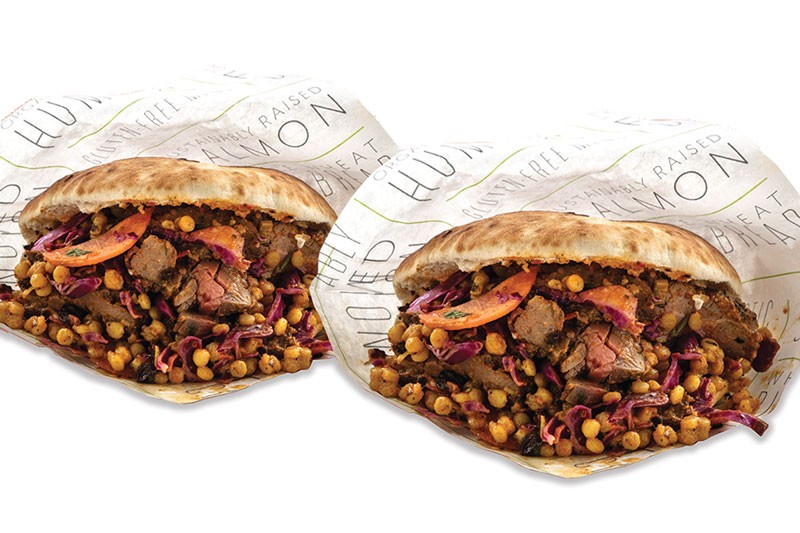 Rōti Modern Mediterranean
Rōti Modern Mediterranean Rōti Modern Mediterranean launched the Roasted Red Pepper Steak Pita last June as part of its six new curated items in the brand’s “2 for $20” sandwich box promotion.
Bigger Piece of the Off-Premise Pie
Last June, Buffalo Wild Wings opened up its first Buffalo Wild Wings GO in Sandy Springs, Ga. It offers a limited menu with a few tables. “It’s our new engine for to-go orders,” says Jamie Carawan, VP of brand menu and culinary with Inspire Brands, parent company of Buffalo Wild Wings, Sonic Drive-In, Rusty Taco, Jimmy John’s and Arby’s. “It augments markets that we’re in now, maximizes delivery opportunities and frees up real estate in our stores.”
Other brands are coming up with different ways to reach those same goals. Cutler says that plans to open an Aussie Grill with a drive-thru lane got pushed up because of the pandemic. It opened in Wesley Chapel, Fla., in June and is thriving. “There was concern that a drive-thru lane would make the fast-casual concept seem fast food-ish,” he says. “It’s doing great. I won’t open another Aussie Grill without a drive-thru component.”
Blaze Pizza already had assembly lines for delivery set up in the restaurant’s footprint, so retooling the space wasn’t a concern. Twin Peaks is including second cook lines in new build-outs and will then retrofit in existing units where possible. “We need more fire power,” says Sadowsky. “Once we have those lines up and running, then we will test multiple limited-menu concepts out of one kitchen—potentially.”
Some brands are pondering dark (or ghost) kitchens. “I’m talking with the architect about what 2021 looks like for Blaze,” says Kent. Dark kitchens are moving into the forefront, thanks to their delivery-only model. With no dine-in service or consumer-facing presence, they relieve the pressure of takeout and/or create opportunity in new markets. Weir confirms that Modern Market is considering options. “We’re exploring ghost kitchens in existing markets—in trade areas where we don’t already have a presence,” he says.
In response to the new reality post-shutdown, Daily Grill Restaurant & Bar, a Grill Concepts casual-dining chain based in Los Angeles, has developed a new brand that runs off the existing line at Daily Grill locations.
O.C. Breads & Bowls features bowl builds and flatbreads, but its menu is only available through third-party delivery. “It’s a different concept served out of our kitchens,” says Tamra Scroggins, director of culinary with Daily Grill. “We launched O.C. Breads & Bowls virtual kitchen because we needed another revenue stream, given that we could only operate at 50 percent. We utilize Daily’s staff and in-house items, and it’s run off the same line. The model seems like it should fit really well in this new foodservice landscape.”
We launched O.C. Breads & Bowls virtual kitchen because we needed another revenue stream. We utilize Daily’s staff and in-house items, and it’s run off the same line. The model seems like it should fit really well in this new foodservice landscape.
Tamra Scroggins, Director of Culinary, Daily Grill
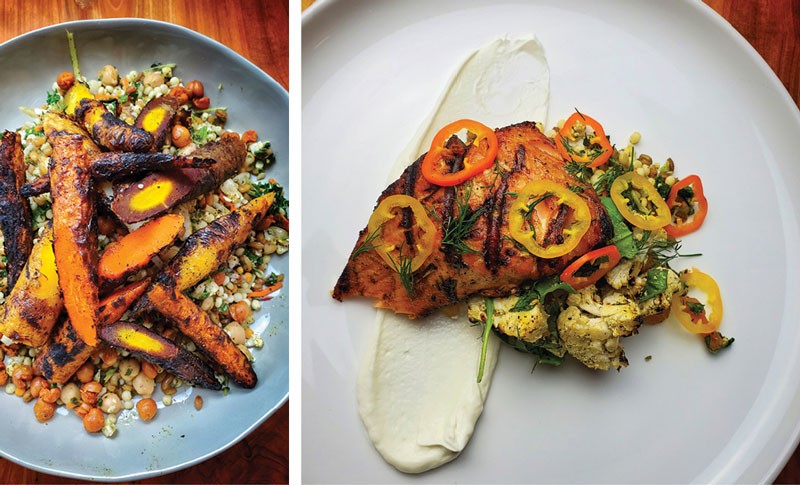 Creative Dining Services
Creative Dining Services Creative Dining Services’ Ian Ramirez underscores the continued imperative for developed flavors: Grilled Garam Masala & Curry Carrots on a couscous-feta-salad and mixed whole grains; and a 24-hour “umami” marinated salmon with grilled cauliflower marinated in za’atar and lemon Greek yogurt, served over a swipe of labneh.
FLAVOR INNOVATION PIPELINE
With so much focus on delivery strategies, safety protocols and basic survival, where are chains in their innovation cycle? Has the pandemic made them retreat fully into comfort, or is it just a fallback position until consumers begin to feel some semblance of normalcy again? Who’s still innovating and what’s in the pipeline?
Brand Focus
“We are going to come out of this and once business is kicking it again, the marketing department is going to ask, ‘What have you got for us?’, and we have to be ready,” says Inspire Brand’s Carawan. “Our innovation teams have been in the test kitchens the last few months, doing flavor development that’s close in, mid-level and further out there.”
We are going to come out of this and once business is kicking it again, the marketing department is going to ask, ‘What have you got for us?’, and we have to be ready. Our innovation teams have been in the test kitchens the last few months, doing flavor development that’s close in, mid-level and further out there.
Jamie Carawan, VP of Brand Menu and Culinary, Inspire Brands
Buffalo Wild Wings rolls out its Asian Zing Wings in September: cauliflower “wings” with ginger-soy garlic sauce, sesame seeds and pickled Fresno chiles. “We’ll run it on our Bar Food menu, and the cauliflower wings will also be an option on our Wings menu, so guests can customize them with any sauce or dry rub.”
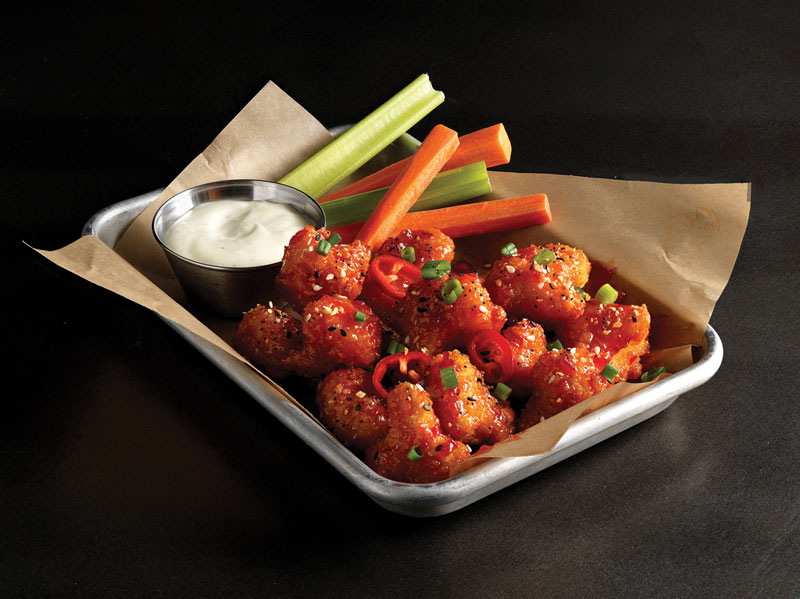 Buffalo Wild Wings
Buffalo Wild Wings As part of its continued innovation push, Buffalo Wild Wings rolls out Cauliflower Zing Wings in September: cauliflower “wings” with ginger-soy garlic sauce, sesame seeds and pickled Fresno chiles.
Rōti is focusing in on flavor innovation that can deliver on consumer preferences, but also help the brand pivot quickly if needed. “We have a very robust pipeline, but we want flexibility to change on a moment’s notice. As everything is moving and changing so quickly at the moment, we need to make sure we’re keeping up with our consumers’ lifestyles and preferences,” says McGrath.
Sauce innovation comes into focus, she says, because the fact that they’re made by hand means that it’s relatively easy to create new flavors. “We are looking to new partners in protein—both animal and plant-based. We want proteins in plain formats so we can sauce them ourselves. We’re working on tahini-based sauces and some pesto/herby sauces that bring both freshness and flexibility. We want a few slam dunks that are easy to prep and ready to turn on when we need them.”
We are looking to new partners in protein—both animal and plant-based. We want proteins in plain formats so we can sauce them ourselves. We’re working on tahini-based sauces and some pesto/herby sauces that bring both freshness and flexibility. We want a few slam dunks that are easy to prep and ready to turn on when we need them.
Molly McGrath, Chef and Culinary Director, Rōti Modern Mediterranean
Trend-forward limited-time offerings (LTOs) are a huge part of First Watch’s business, but for the remainder of 2020, the plan is to bring back past menu items. “We’re staying focused on fan favorites and LTOs that we’ve run in the past,” says Schaibly. “Supply chain issues, familiarity and the financial part of LTO inventory is part of that decision, too. We have enough new news to keep our guests excited for the next six months and release pressure on the distribution side.” The Hacienda Hash, Carnitas Breakfast Burrito and Pumpkin Pancakes are all making a comeback for the fall. “They hearken back to comfort food and our customers hold them close to their hearts.”
Modern Market and Lemonade are following a similar LTO strategy and funneling innovation efforts into different areas. “We don’t think we can get a lot of traction to break through the noise right now,” says Weir. “Our sense is that customers are going to gravitate toward the familiar anyway. We also want to reduce complexity for our teams and improve core items so they travel better. And we’re looking at ways for our food to be even safer, perhaps. That’s where we’re focusing our innovation.”
Weir is optimistic about the future, putting energy behind “bigger picture projects,” he says. He cites protein solutions as one area of focus, looking to increase the use of sous-vide products. “The pandemic has forced us to think about contingencies that we never had to deal with in the past,” he says. “Next year, I’d like to look at innovations and changes we’d like to make, instead of those that we’ve had to make.”
Looking ahead to 2021, First Watch is ready with a stacked pipeline. The Jumpstart LTOs, launching in January 2021, include a Crab Avocado Toast with fresh blue crab salad, lemon zest, chives and pickled red onion on whole-grain artisan toast. The colorful and distinctive Purple Haze Lemonade stars butterfly pea tea, lemonade and lavender.
We also had a responsibility to our growers, especially during this time when they were having to let fields of produce die in the sun. Getting those watermelons to market was important to me and to the brand.
Shane Schaibly, VP of Culinary Strategy and Corporate Chef, First Watch Restaurants
Schaibly talks about the brand’s flagship fresh juice program, noting its huge success in off-premise sales. “From a percentage standpoint, fresh juices are doing better in to-go than in restaurants—and that’s significant for us,” he says. The brand continued with its planned summertime LTO, despite the challenges in getting it to market. The Watermelon Wakeup boasts a refreshing blend of watermelon, pineapple, lemon and mint. “If that was the only product news we had, we wanted it to be loud,” he says. “We also had a responsibility to our growers, especially during this time when they were having to let fields of produce die in the sun. Getting those watermelons to market was important to me and to the brand.”
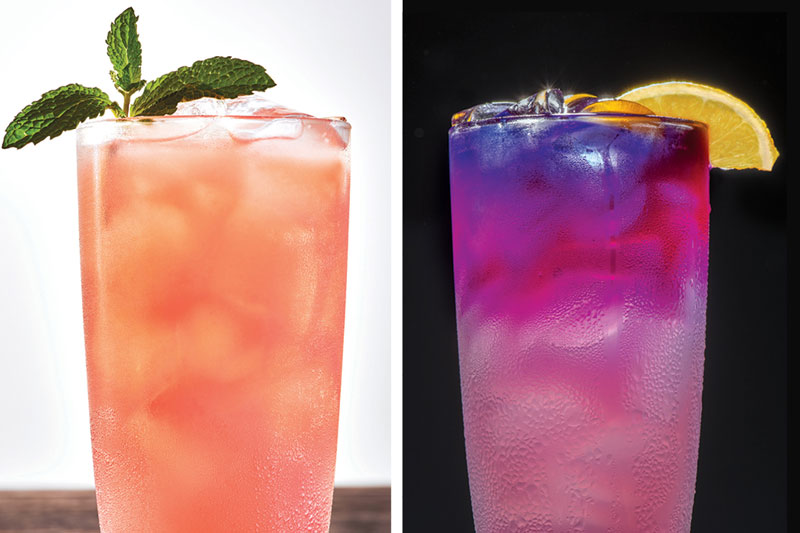 First Watch
First Watch First Watch’s flagship fresh juice program, performing even better in the to-go model, features a summer LTO called Watermelon Wakeup, with watermelon, pineapple, lemon and mint (left). As a 2021 “Jumpstart LTO,” it’s planning the eye-catching Purple Haze, with butterfly pea flower tea, lemon, cane sugar and lavender (right).
A Little Help, Please
Of course, the pandemic upended noncommercial foodservice, too. Changing protocols and dealing with supply issues for volume feeding in the college and university space, business and industry, and healthcare segments is no small feat. Innovation, then, looks very different in this segment. Ian Ramirez, director of culinary innovation with Creative Dining Services, a hospitality and dining services provider based in Zeeland, Mich., says that the priority has been setting up, installing and teaching stringent safety protocols, outlined in the rollout of its 36-page COVID playbook.
“We still need to provide high quality, flavorful food, but we need a little help with labor in order to create a safe working environment for our staff, and to ensure social distancing in the kitchen, we need to be creative with food prep. True innovation for us right now is coming from finding semi-prepared, speed-scratch products like pre-cooked grain mixes, partially prepared or cut proteins and pre-cut vegetable blends, but keeping that same quality,” says Ramirez. “I’ve got eyes out looking for those products and that kind of support.”
We still need to provide high quality, flavorful food, but we need a little help. True innovation for us right now is coming from finding semi-prepared, speed-scratch products like pre-cooked grain mixes, partially prepared or cut proteins and pre-cut vegetable blends, but keeping that same quality.
Ian Ramirez, Director of Culinary Innovation, Creative Dining Services
Flavor development is still in the crosshairs. “We just wrapped our Innovative Solutions Week, where our culinary team focused on the importance of flavor building,” he says. They dove into trend-forward ways to marinate and season ingredients. Ideation resulted in menu ideas like a 24-hour “umami” marinated salmon; cauliflower marinated in Greek yogurt flavored with za’atar, lemon, fresh dill and basil, then grilled; and grilled garam masala and curry carrots.
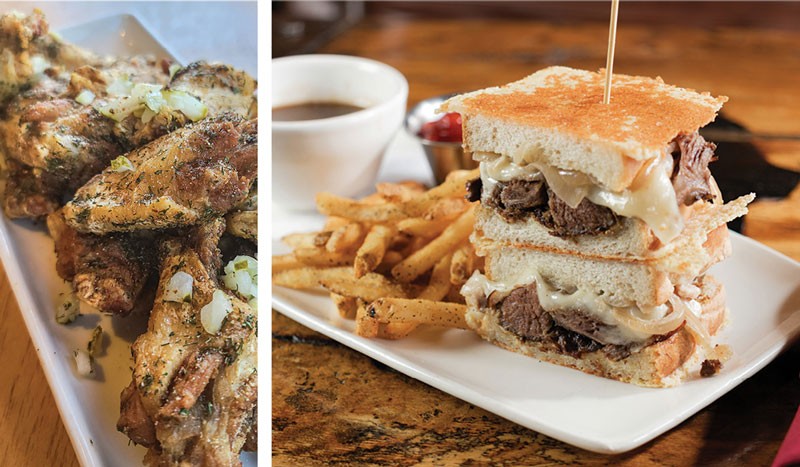 Twin Peaks
Twin Peaks Pushing innovation in its wings platform, Twin Peaks has Spicy Dill Pickle Chicken Wings teed up for 2021: pickle-brined, smoked then grilled, and tossed with a spicy dill dry rub, then garnished with Twin Peaks dill pickles. Staying in the comfort zone in other parts of the menu, the Pot Roast French Dip, another item for 2021, sees beer-braised pot roast, Swiss, caramelized onions on Parmesan-crusted bread, with horseradish au jus.
Balancing Comfort with Adventure
Comfort food is always in vogue, but of course, today, consumers are yearning even more for the safe, familiar, satisfying flavors and formats that they know and love. Innovation within comfort-centric parameters makes good sense for the foreseeable future. On the other hand, some consumers are ready to pick up where they left off pre-pandemic, embracing the bold, the new and the unexplored. Where’s the balance? Has it shifted for brands?
“It’s a little bit of both for us,” says Twin Peaks’ Sadowsky. “We’re seeing them skew more toward comfort food, like we saw in 2008. But we’re still going to innovate within comfort—we were already on that path. We’re looking at the premiumization of comfort food.” The challenge, he says, is keeping guests excited, but gauging where they are in their comfort levels. “My focus with innovation is how to get more efficient, stay ahead of flavor trends to curate a premium culinary adventure that our guests count on,” he says. “Determining the right time to start pushing the envelope again is a balancing act.”
My focus with innovation is how to get more efficient, stay ahead of flavor trends to curate a premium culinary adventure that our guests count on. Determining the right time to start pushing the envelope again is a balancing act.
Alex Sadowsky, Corporate Executive Chef, Twin Peaks
Twin Peaks is using its chicken wings platform as a launch pad for trend-forward flavors. “We can play more in that space because people are more open to trying new flavors in the context of wings,” he says. “I can bring something in like black garlic, harissa, gochujang—you name it, that’s where we can try it.”
For rollout in early 2021, he’s playing both sides with menu development, turning to flavors that aren’t common on wings, but infinitely familiar to consumers. “We’re working with flavors that people are used to, like a flavor on potato chips that could go nicely onto a chicken wing. They don’t have to risk much by trying it on wings, and it’s something craveable and distinct,” he says.
In other categories, the comfort zone is tighter. “With entrées, we have to live way more in the comfort category; same with sandwiches and burgers,” he says. To that end, Twin Peaks is developing its take on a classic patty melt and is rolling out a Pot Roast French Dip in early 2021.
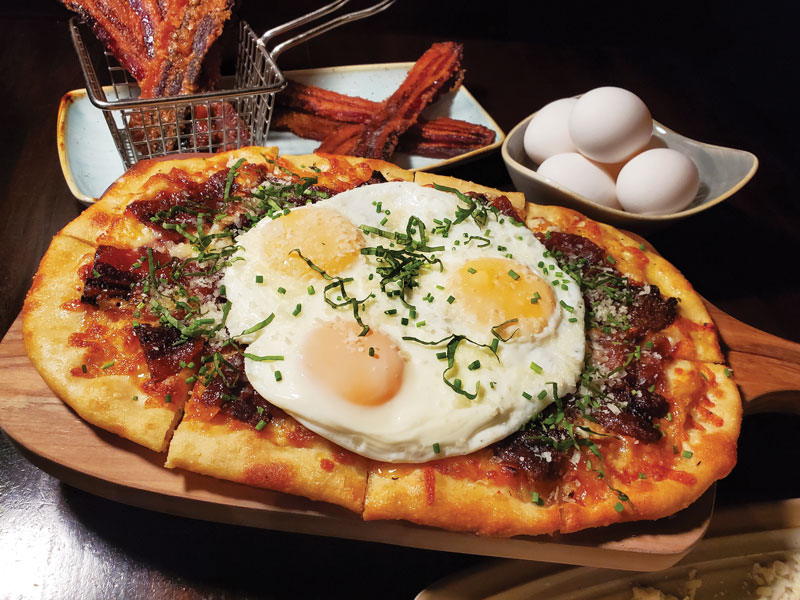 Village Tavern
Village Tavern Village Tavern leaned into comfort-centric menu development with its new Breakfast Pizza, featuring sugared bacon, caramelized onions, Parmesan and a fried egg.
Mary Grace Viado Howard, corporate executive chef of Village Tavern, a neighborhood restaurant concept based in Winston-Salem, N.C., says the brand is currently approaching innovation a little more cautiously than before. “We’re more careful right now because it’s about survival, but we’ll be back on track for 2021,” she says. “We are looking at more plant-forward menu development for next year. Asian and Indian influences are going to be stronger because of our ideas for plant-forward menu items.”
We have such an extensive menu, I wanted to be sure to use existing SKUs, but create something new and comforting.
Mary Grace Viado Howard, Corporate Executive Chef, Village Tavern
During the shutdown, she developed a comfort-centric Breakfast Pizza for the brunch menu. “We have such an extensive menu, I wanted to be sure to use existing SKUs, but create something new and comforting,” says Viado Howard. The pizza boasts mozzarella, sugared bacon, caramelized onions, Parmesan, chives, basil and a fried egg. She’s also looking to the pasta category for more comforting profiles and is working on a cacio e pepe bucatini.
Cutler says that innovation strategies vary from concept to concept under the Bloomin’ Brands umbrella. “With Fleming’s, we are working on crazy-good, addictive food. It’s not just about the steak—it’s the peppercorn sauce, it’s the Fleming’s Potatoes. We’re working hard to make the menu appealing and unique to our brand,” he says. “At Outback, we’ve reduced the menu substantially, and we’re focusing on our steak authority, value for money, emphasized by convenience and focusing on flavor.”
Although COVID has been devastating in so many ways, it has compelled restaurant brands to take stock, assess, regroup and reimagine. “The pandemic has given the industry an opportunity to scrutinize our menus, take what was good and make it better, or reinvent parts of the business altogether,” says Cutler. He sees the yearning so many consumers have for comfort as a desire for connection. “I think they crave being together, going out and enjoying a meal together. They are hungry for a restaurant experience,” he says. “They want celebratory food.” Consumers want hospitality, and as always, the foodservice industry is ready for them.

